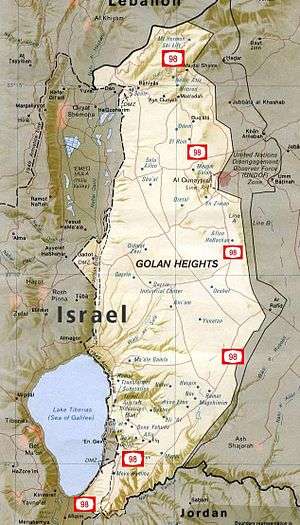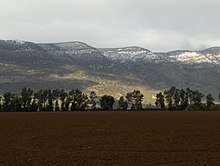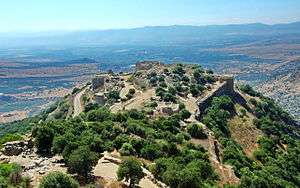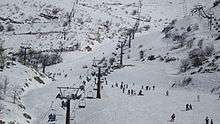Golan Heights
The Golan Heights is a rocky plateau at the southern end of the Anti-Lebanon Mountains, and straddles the borders of Syria and Israel. Israel holds about two-thirds of the territory, which it captured in the 1967 Six-Day War and annexed in 1981, while Syria holds the remaining one-third.
| WARNING: There is fighting between Syrian government and opposition forces in the Syrian-controlled Golan. Most of the Israel–Syria border is now controlled by rebel groups including Al-Nusra (affiliated with Al Qaida) and the Yarmouk Martyrs Brigade (affiliated with ISIS). Since early April, 2015, no UNDOF peacekeeping troops have been in Syria. The situation is fluid; some mortars have been fired either accidentally or intentionally at Israeli-run areas, there have been a few Israeli fatalities, and the Israeli Air Force in turn is believed to have killed some high-ranking Hezbollah officials and an Iranian general who were reportedly trying to set up missile batteries in order to attack Israel from the Syrian-controlled Golan. So if you plan to visit the Golan, check on current conditions and exercise caution. | |
| (Information last updated Mar 2017) |
- Not to be confused with the Syrian-controlled part of the Golan Heights.
The Golan is mostly known among Israelis for its beautiful landscapes and hiking trails, and for the Hermon ski site.
|
Israel formally annexed the portions of the Golan Heights it controls in 1981. This annexation is only recognized by one other country — the United States, and is not recognized by the United Nations. This page does not represent a political endorsement of the claims of either side of the dispute. |

Cities
- 🌍 Katzrin – The largest Jewish town in the Golan (pop. 7000), known in Israel as the "capital of the Golan".
- 🌍 Majdal Shams – The largest Druze village in the Golan (pop. 10,643). Nearby is the Shouting Hill where villagers communicate with their relatives in Syria.
- 🌍 Buq'ata – A Druze town in the far northeastern part of the Israeli Golan Heights, with a population of around 6,300.
Other destinations
- 🌍 Giv'at Yo'av – An Israeli settlement and moshav shitufi, established in 1970.
- 🌍 Keshet – An Israeli settlement and moshav shitufi, established in 1974.
- 🌍 Merom Golan – The oldest Israeli settlement and kibbutz of the Golan Heights, established in 1967. It is near the crater of Mount Avital.
- 🌍 Neve Ativ – An Israeli settlement and moshav shitufi, established in 1972. Located in the very north, it is the most important ski destination in Israel.
- 🌍 Odem – An Israeli settlement and moshav shitufi, established in 1975 and located on Mt. Odem, 1,090 meters above sea level.
Understand
History and politics
Two-thirds of the Golan Heights has been under Israeli control since 1967, when Israel seized the area during the Six-Day War. The remainder is under Syrian control. Following the 1973 Yom Kippur War, Israel returned another 5% of the land to Syria. Israel began building settlements in the area, and granted the Syrian Druze inhabitants permanent residency status. In 1981, Israel annexed the Golan Heights.
Unlike the West Bank, the part of the Golan Heights controlled by Israel is considered part of the country by most Israelis and by the Israeli government. Security is on par with Israel proper, and you won't find roadblocks.
In Israel, it is generally understood that the Golan Heights will not be returned to Syria. The Israeli viewpoint is that this would not be feasible due to economical and political reasons, and for reasons of security which they believe have only strengthened since the Syrian civil war started. There are no negotiations between Israel and Syria and this not likely to change any time soon.
The de facto Israel-Syria border runs through the Golan Heights along an area known as the Purple Line. This line was until recently patrolled by a United Nations peacekeeping force, but the peacekeepers were attacked by the Syrian opposition and all of them have been withdrawn from Syria, removing a stabilizing element from the border. No one is allowed to cross the border without special permission, and the border crossing is under the control of Israel and the Al Qaeda-affiliated Nusra Front.
Geography
The Golan Heights mostly consists of a flat plateau made out of volcanic basalt. Near the Israel-Syria line of control (on the Israeli side) is a chain of extinct volcanoes which protrude above the plateau. A number of streams cut through the plateau, forming deep valleys and occasional waterfalls, and eventually end up in the Jordan River or the Sea of Galilee. With the countless Eucalyptus trees growing here and due to the wide plains, it reminds one of New South Wales, Australia.
Due to the flatness of the plateau (unlike Israel's mostly hilly or coastal landscapes), the dark basalt and fertile volcanic soil, and the year-round streams, the Golan Heights looks and feels different from the rest of Israel, so it is a popular destination for Israeli tourists.
The Hermon mountain differs from the rest of the Golan, as well as from any other place in Israel. The highest point in the Israeli-controlled part of the Hermon is 2236 meters above sea level, nearly twice as high as the next-highest place in Israel (Mount Meron in the Upper Galilee). As a result, the Hermon gets far more snowfall than anywhere else in Israel, and it is the site of Israel's only ski resort (in the winter months).
The most popular season to visit the Golan is the spring. For a brief period in spring, the entire Golan landscape is covered by a bed of flowers. Also, at this time the streams and waterfalls are at their most powerful due to the winter rains. Autumn and winter are also good seasons to visit the Golan. Summer is the worst time to visit - Israel gets no rain in summer, so the mostly tree-free Golan landscape turns entirely brown, and the weather is hot and humid. Summer can be a good time for a hike that includes walking in the water (there are several popular ones), or to see historic sites. But hiking anywhere else is best left for another season.

Get in
There is no visible border between the Galilee regions and the Golan Heights. You will not realize that you are entering the Golan Heights, except from the terrain.
It is essentially impossible to cross between the Israeli-controlled and Syrian-controlled parts of the Golan Heights, so don't bother trying.
By bus
There are a few daily buses from Tiberias, Hatzor and Kiryat Shmona to the Golan Heights, operated by Golanbus. Services are infrequent due to the low population. There are also a handful of direct buses to Tel Aviv, Jerusalem, and Haifa.
By car
Private transportation: from north-south route 90, there are four road "ascents" to the Golan Heights.
Hitchhiking
Hitchhiking is accepted here as it is throughout Israel, but you can still wait a long time to get to many destinations. Hitchhiking is easiest in the southern Golan Heights, as more people live there. In the center and north, the traffic is mostly tourists, who are less likely to pick up hitchhikers.
By plane
Before the construction of some roads in the region during the 1990s and early 2000s flying into the area from other parts of Israel was moderately common. You can still do that if you have more money than sense and you might even save a bit of time doing it, but really unless you are an aviation buzz, it is unlikely to bring any real benefit over overland entry.
- 🌍 Rosh Pina Airport (RPN IATA).
Get around
This area, due to low population, has one of the worst public transport services in the entire country, with some bus stops receiving as few as two or three buses daily.
You might try hitch-hiking, which is used by Israelis of all ages and gender. You can rent a car as well, but only from a few rental services.
See
Natural sights
The Golan Heights is the wettest area in the region. There are many waterfalls including the Gamla, Sa`ar and the Banias waterfalls. It is especially recommended to visit the Golan Heights in spring, when the ground is covered with wildflowers. The waterfalls are strongest then too.
- 🌍
Gamla Nature Reserve (Hebrew:גמלא) (turn off the Sea of Galilee Road at Gamla Junction and then take Route 869 to Daliyot Junction, turning north after about 2 km; a signposted dirt road leads to the reserve), ☎ +972 4-6822282, e-mail: st.gamla@npa.org.il. winter 08:00-16:00, summer 08:00-17:00, closing one hour earlier on Fridays and eve of holidays. A picturesque nature reserve and archaeological site of a Jewish stronghold from 87 BCE. Gamla means a "camel" in Hebrew, the name of the hill top location clearly taking its name from a resemblance to a camel's hump.
Gamla was the capital of the Golan Heights in the 1st century. In 66 CE, along with other Jewish cities in the region, it launched a rebellion against Roman rule. After a siege the city was conquered, and its inhabitants were either killed or threw themselves from the cliff at the edge of the city. Nowadays the city has been partly excavated, and fortifications as well as a synagogue can be seen.
There are several trails at the site, some of which will be challenging for people who are out of shape or hike rarely. The Gamla waterfall trail is accessible until 14:00/15:00 (winter/summer). The Gamla ancient town trail is accessible until 13:00/14:00 (winter/summer). Also, the steep and tall cliffs at Gamla form the perfect habitat for griffin vultures. ₪28/24/14 adult/student/child. - 🌍 Wadi Daliyot Reserve. This picturesque valley and trail leads into the Gamla Nature Reserve and requires the payment of the same fee. However, walking from the highway to the Gamla site, there are no fee collection points and you are supposed to pay at Gamla, which you can circumvent by just walking back before reaching Gamla. This can be a good alternative to Gamla, in case you want to save the steep entrance fee. Part of Gamla fee.
- 🌍 Sa'ar Fall & Viewpoint (right by the road).
- 🌍 Golan Volcanic Park. 10:00-16:00. There is no volcanic activity, but a nice park explaining different volcanic facts. The site includes art in the volcanic gravel.
Historic and other sights

- 🌍 Nimrod Fortress National Park (Nimrod Castle, Kalaat Namrud), ☎ +972 4-6949277. winter 08:00-16:00, summer 08:00-17:00, closing one hour earlier on Fridays and eve of holidays. An ancient fortress in the northern Golan Heights, built in the 13th century by Muslim rulers to defend against a possible Crusader attack. It is located on a steep mountain ridge, with deep forested ravines on either side, and has a stupendous view of its surroundings. A trail leads from the fortress's west edge downhill several kilometres to Banias, another important historical and nature site in the area. Hike: ~2 hr. ₪22/9 adult/child, ₪41/20 adult/child combined with Banias.
- 🌍 Mount Bental. A mountain in the eastern Golan Heights with an Israeli stronghold (formerly a Syrian stronghold) on top and views of Syria to the east and the Golan Heights to the west. On some days, you might hear or even see a bomb going off in the distance, part of the Syrian Civil War. From this distance, it sounds like thunder. You can explore the Syrian army bunkers here from before 1967.
- 🌍 (Golani Observation Point) Tel Faher (Tel Pakhar). A Syrian military post between 1948-1967. In that period the Syrian army would shell Israeli agricultural settlements in the valley below as part of border disputes. The post was conquered by Israel in a bloody battle in 1967. It is now the site of a memorial, and you can explore the Syrian bunkers, which have a great view down to the fields of the kibbutzim.
- 🌍 Observation to Quneitra. Quneitra is a ghost town, which was abandoned by the Syrians during the 1967 war and left in the no-man's-land ever since. Thoroughly wrecked not only in 1967 but in the subsequent 1973 conflict as well, from the Israeli side, the area can only be viewed from designated viewpoints set up along the border road, as it's just across the de facto line of control.
- 🌍
Rujm el-Hiri (Gilgal Refaim) (A 4 km walk east on the Golan Trail from Daliyot junction (the road junction closest to Gamla)). A large megalithic monument dating to around 3000 BCE. It consists of concentric stone circles, and is sometimes called the "Stonehenge of the Levant", without the big upstanding rocks but with a small cave inside. It is hypothesized to be an astronomical and/or ritual site. It looks very impressive from the air, but is difficult to appreciate from ground level.
- Nearby, an 🌍 abandoned bunker can be found and explored. Bring a flashlight and don't go on your own.
- 🌍 Kursi. An archaeological site on the eastern side of the Sea of Galilee and north of Ein Gev.
- 🌍 Deir Aziz synagogue. A Byzantine-era synagogue, partly reconstructed, with impressive pillars.
- 🌍 Umm el Kanatir. A Byzantine-era Jewish town including a synagogue. The synagogue is being excavated and reconstructed (until May 2018) and closed to general visitors, although some tour guides can get you in and let you take part in the excavations.
Do
Hiking
Hiking is the activity of choice in the Golan Heights. Many sights are only reachable on foot, and it is a great way to see and explore the area. Having said that, most tracks are short in distance.
- Golan Trail. A hiking trail, for anything between a day and a week.
- 🌍 Ein Tina (עין תינה). A short, enjoyable hike through a running stream to the spring which feeds it. Great for hot summer days.
- 🌍 Yehudiya Forest Nature Reserve, Yehudiya-Hushniya Road (87) (7 km east of the Yehudiya junction, approximately 5.5 km south of Katsrin), ☎ +972 4 6962817, e-mail: st-yehudya@npa.org.il. winter 08:00-16:00, summer 07:00-17:00, closing one hour earlier on Fridays and eve of holidays. Amazing hikes through natural pools. A must do for anyone with a strong sense of adventure and some basic athletic ability. Different hikes with different difficulty levels. ₪22/11/9 adult/senior/child (incl. Meshushim Nature Reserve), ₪16 camping (advance reservation).
- 🌍 Nachal Zavitan. A very popular water hike including a number of waterfalls.
- 🌍 Hexagon / Meshushim Pools (Meshushim Stream Nature Reserve) (Hike 3.6 km from highway 888 or about 7 km from highway 87), ☎ +972 4-6820238. winter 08:00-16:00, summer 08:00-17:00, closing one hour earlier on Fridays and eve of holidays. A set of famous pools in the Meshushim river with natural hexagonal volcanic tiling. Within the Yehuda Brechat HaMeshushim Site Nature Reserve. price see Yehudiya Forest Nature Reserve (one ticket).
- 🌍 The Majrase (Daliyot estuary) (Betiha (Bet Tsayda Valley) Nature Reserve), ☎ +972 4-6793410. winter 08:00-16:00, summer 08:00-17:00, closing one hour earlier on Fridays and eve of holidays. A very nice water hike in the wetlands along the north Sea of Galilee shore. You walk for about 1.5 km in the river, including some swimming (you must know how to swim). Bring shoes to wear in the water. There is also a dry path if you don't want to get wet. This is near the New Testament site of Bethsaida. ₪28/24/14 adult/student/child.
- 🌍 Nachal El Al. A 5-km hike between the communities of Eli Ad and Avnei Eitan. You descend into a beautiful canyon with flowing water, and pass by the "White Waterfall" and "Black Waterfall" - so called because the different layers of rock have different colors.
Skiing

.jpg)
- 🌍 Mount Hermon Ski Region, ☎ +1 599-550-560. 08:00-15:00. Mount Hermon is Israel's highest mountain (2284 m), home to country's sole ski resort. There is snow for only part of the year (between mid-January and March), so check ahead. At other times, you can still visit and enjoy the views, the wildflowers, and so on at a much cheaper price. There is a cable car going up the mountain. Access is by private car - there is no public transportation within about 10 km of the ski site. The ski company offers bus trips from Tel Aviv to the ski site (call for details). Ski prices are about ₪200 for equipment rental and ₪200 for ski-pass. Paid shuttle and cable car (ski pass ~₪250 a day, ski equipment ~₪280 a day).
Other activities
- 🌍 Aniam artists' village. A quaint artists' village where you can see many of the artists working in addition to perusing and buying their works. In the valley south of Aniam is a picturesque river and water pool. Further up the valley (just before the main road, route 808) is the Ayit waterfall, which is impressive in winter but totally dry in summer. All these sites are in walking distance from each other.
- Robotic dairy farm (Avnei Eitan), ☎ +972 50 4060311. This farm has a visitors' center for people interested in experiencing robotic cow milking. There is an explanatory video, then you see the cows, and kids get the chance to feed calves milk from a giant bottle. You get to make butter, and drink a cup of hot chocolate from the just-produced milk.
- Kol Shofar (Givat Yoav). A shofar factory with a visitors' center where you can learn about and observe the shofar manufacture practice.
- Slingshot Israel. An interactive adventure taking place in an old military bunker on the Syrian border, sponsored by the IDF. Best done at night. A variety of unique IDF-oriented programs are offered.
Eat
- Fruit picking – A number of places in the Golan offer fresh fruit picking in the summer and autumn months. You pay up front, and get to eat as you pick as well as bring a basket home. It's regarded as a fun activity for couples and families. See list here.
- 🌍 Meat Shos (מיטשוס), Qatzrin, ☎ +972 4-696-3334. opens 13:00. A steak house popular with the locals in Qatzrin.
- 🌍 The Cowboy Restaurant (Habokrim Restaurant), Merom Golan, ☎ +972 4-696-0206, +972 53-9443658. opens 12:00. Meat and wine. Rated a great 8.4 out of 10.
- 🌍 De Karina Chocolate Factory, Kibbutz Ein Zivan.
Drink
See also Katzrin.
- Bahat Winery (Kibbutz Ein Zivan). Also serves food such as pizza and salads.
- Golan Height Winery, Industrial Zone Katzrin, ☎ +972 4-6968435, fax: +972 4-6964004, e-mail: winetour@golanwines.co.il.
Sleep
- 🌍 Narkis Boutique Hotel (Just outside the city centre of Majdal Shams), ☎ +972 4-698-2961. A popular and modern hotel.
- 🌍 Rimonim Hermon Holiday Village, Moshav Neve Ativ, North Golan, ☎ +972-4-6985888. Offers accommodations in wooden cottages in a natural surrounding with nature corners, trees, lawns and breathtaking scenery. ₪550.
Budget
- 🌍 Golan Heights Hostel, Moshav Odem, ☎ +972 54-260-0334, e-mail: info@golanheightshostel.com. Highly rated. Member of ILH. ₪100/270 dorm/double.
- 🌍 Freedom Guesthouse, Ha-Perakh be-Gani 234, Had Nes, ☎ +972 50-3059679, e-mail: freedomguesthouseil@gmail.com. Rated 4.8 out of 5. Member of ILH. Dorm bed from ₪95, double from ₪270.
- 🌍 Genghis Khan, Giv'at Yo'av (having a good map, you can hike up from the road along the lake), ☎ +972 52-371-5687. Staying in a outdoor yurt. Grumpy owner and sheets are extra. But seems to be a good (family) experience. Member of ILH. Dorm bed ₪100 plus sheets.
Mid-range
Several tsimmers (bed & breakfast) are available on Zimmer.co.il.
- 🌍 Keshet Debbie (Debbie's Rainbow Tzimmer), Keshet, ☎ +972 52-282-6205, e-mail: debbyattoun@bezeqint.net.
- 🌍 Keshet Yonatan hosting and camping (אירוח וקמפינג קשת יהונתן), Keshet, ☎ +972 4-685-1100. Rated 2.6 out of 5.
- HaNof HaTzfoni (הנוף הצפוני), Ortal, ☎ +972 52 9120148.
Splurge
- 🌍 Merom Golan, Kibbutz Merom Golan, ☎ +972-4-6960267. Kibbutz Merom Golan sits in the north of the Golan Heights, at the foothill of the extinct Ben Tal Volcano some 1000 meters above sea level. ₪400+.
- 🌍 Golan Rooms, Moshav Ramot, ☎ +972-4-6731814. Offers 10 guest cottages surrounded by a large garden on a hillside overlooking the Sea of Galilee. ₪530+.
Stay safe
The Golan is mostly a rural area, and as such it is pretty much crime free. However, the Golan is also one of the world's largest military barriers, and while it offers many hiking options, several basic safety rules should always be followed:
- A large part of the Golan Heights area is either heavily mined, or is suspected as being mined - this is because old mines may drift during heavy rains, which are frequent in winter. You should never walk or drive in open fields, off main roads or dirt roads (unless there are very clear signs which indicate that this area is safe, such as trail signs). While most mine fields are designated by warning signs (as the one shown in the picture), do not go into off-road barb-wired fields, even if they are not marked with signs (in short, never cross any fence unless there are clear signs and/or suitable gateways in the fence). Never touch unidentified metal or plastic debris in the open even if it looks harmless.
- Some areas of the Golan are used by the Israeli military as training grounds. There are usually recognised by the "Firing Zone" signs in the entrance. While marked trails are pretty much safe, when going off-road you should check the local maps to make sure you are not going into a fire ground. If in doubt, check with local police or military authorities. Most training grounds are accessible during weekends (Fridays - Saturdays) and public holidays, and can also be accessed after coordination with military authorities.
- Due to the civil war in Syria, you may hear heavy bombing sounds. A few bombs shot by either side have drifted into the Israeli-administered part of the Golan, where they hit open ground near the border. You may want to keep a safe distance of a few miles from the border as a precaution.
Go next
- The Sea of Galilee region and the holy city of Tiberias.
- The Galilee Panhandle and rural area of Kiryat Shmona.
- The Lower Galilee and Upper Galilee and its exciting and interesting cities Nazareth and Safed.